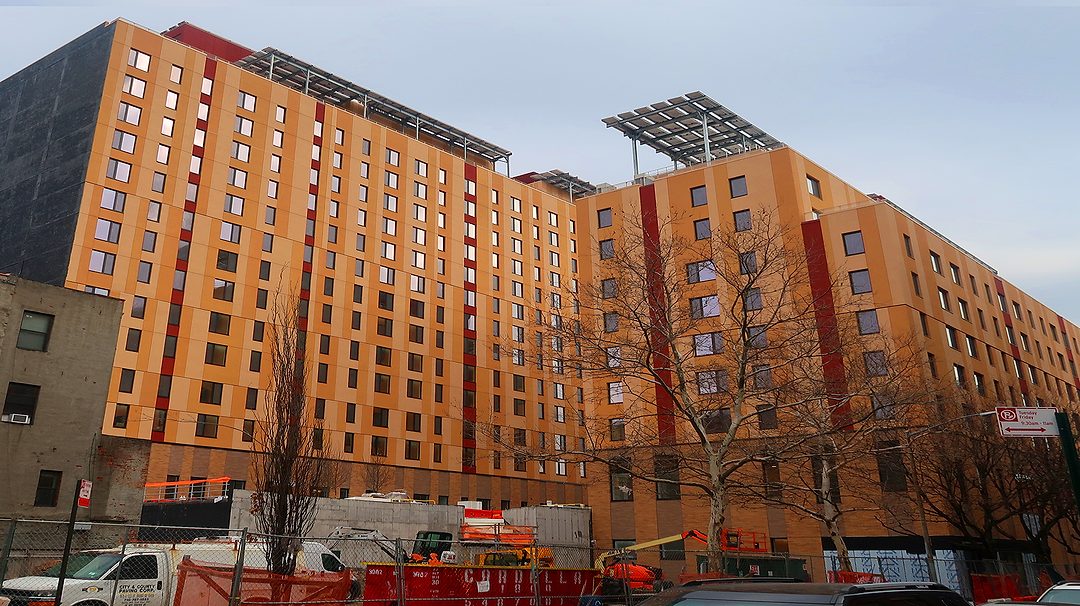Clean Energy Systems Get BIG
Passive House projects in Boston and NYC are reducing carbon emissions and conserving energy.

For me, 2022 began with the return to my routine, but it was anything but routine. Armed with three COVID-19 shots and a flu shot, I was able to visit different cities once again and review climate solutions for buildings, transportation, microgrids and other power systems. And then, I attended the AHR Expo in Las Vegas Jan. 31-Feb. 2. Wherever I went, it seemed as if something big was happening.
I expected to feel the usual mixed emotions: The optimistic side of me would be excited to report great new progress on clean energy and clean water systems. The pessimist would bemoan the plodding, bureaucratic, incremental pace of change that is always inadequate for an impatient environmentalist.
But guess what? The optimist easily won the day. Not only is change penetrating all corners of the building industry, but it’s accelerating like a Tesla Model S.
I discovered more than a technology shift or two; rather, a broad technical and economic disruption of the construction industry. Heating, cooling, ventilation, controls, building envelope, design process, refrigerants, plumbing, civil infrastructure and urban planning are all affected and are all connected.
Yesterday’s trends and buzzwords are falling away or, if they have real value, are becoming today’s mainstream operating practices in clean, efficient energy, water and refrigeration technology, electronics and smart buildings. There are more clearly defined applications for the Internet of Things and artificial intelligence, preventive maintenance and more. Not only are these previously nebulous concepts providing value in real equipment, but they are being applied on a mass scale.
When dramatically different methods are employed on the largest projects, you know we’ve moved beyond rhetoric — like when you visit Boston’s 53-story, 696-foot-high Winthrop Center Passive House project just a few days after snapping pictures on-site at Harlem’s 709-unit Sendero Verde affordable housing Passive House project in New York City.
Or when you walk into the Mitsubishi-Trane booth at the AHR Expo and Cain White says: “There’s no turning back. A massive shift is starting in the U.S. right now.” Then he shows you a new 40-kW, industrial-sized, C02 cold-weather heat pump water heater that can be connected to up to 15 more of the same modules to provide a total of 640 kW (about 2,183,771 BTU/hour). BIG!
This happened a few minutes after David Budzinski informed me at the Johnson Controls exhibit that the company tripled its investment in heat pumps last year. It is still making efficiency gains through ever more digitized and connected building technologies, will soon move to all-natural refrigerants in all products, and will make clean heating systems more accessible through a utility model.
“This is not only a trend,” he says. “We’re well-positioned to help consumers, builders and owners become carbon-neutral. Not only is it a value for corporations from a bottom-line perspective, but it’s something required to attract top talent. The next-generation workforce wants to work for companies that are creating a better world, and we want the next generation to have a safe, healthy and clean environment.”
Winthrop Center in Boston
Brad Mahoney from Millennium Partners (MP), one of America’s biggest urban developers, echoes Budzinski. “This is not just a blip. This is the way that projects will be built,” he says while touring with me through the 812,000-square-foot Winthrop Center site in Boston.
About half of the massive high-rise is of Passive House design, with triple-glazed windows and additional insulation both at the sill and at the head positions in the spandrel areas. Mahoney notes that if design decisions were being made today, rather than four years ago, MP would have likely applied Passive House to the residential floors, which make up most of the other half of the project.
“Lessons learned, right?” he notes. “Boston recently enacted its building energy reporting disclosure ordinance. They call it BERDO 2.0, which is similar to Local Law No. 97 in New York. Starting in 2025, buildings are going to have to cut their carbon intensity. And so this project as a whole is already using 50 to 55 percent less carbon and 55 percent less energy than the average building in Boston.”
The building’s massive 65-foot-high mechanical room floor is located about 300 feet above the city, between the office and residential sections of the tower.
“We’re taking a leap forward,” Mahoney says. “I ran the numbers; if we applied Passive House to the entire building stock in Boston, we would effectively cut our city-wide building emissions in half. And we would reduce the timeline for carbon neutrality by 10 to 15 years. That shows you the power of this technology. It’s striking, and I think it’s resonating with tenants and with Boston.”
The building is expected to have an energy use intensity of 28 KBTU/rentable square feet (rsf) a year as compared to an existing LEED Platinum building, which uses 60 percent more energy (44 KBTU/rsf/year), and a typical Class A building, which uses 150 percent more energy (70 KBTU/rsf/year.)
“No other substantially renovated or new office building in a similar climate can achieve these energy savings without incorporating Passive House standards, which are being adopted within the industry on a wide scale to help cities achieve their aggressive carbon-reduction goals,” Mahoney notes.
Tom Burroughs, senior vice president at WSP Engineering, confirmed that the center’s dedicated outdoor air ventilation system provides high-level health benefits with MERV 15 filtration and real-time indoor air quality monitoring. It provides 5,000 cfm to each floor or about 125,000 cfm for the Passive House floors.
This amounts to 30 to 50 percent more fresh air than the code requires, while the energy recovery ventilators supplying it achieve a 70 to 80 percent energy recovery rate. Vertical ductwork is sealed to minimize inefficient air leakage.
To add to efficiency, the control system varies settings while accessing two occupancy data systems, specifically C02 sensors, plus employee security badge swipes.
The façade employs a state-of-the-art, high-performance unitized curtain wall system, triple-glazing that exceeds double-glazing performance by 15 to 20 percent and single-glazing by 50 to 60 percent. Vision glass is 10-foot high across the majority of the floor plate.
Cooling is supplied by the central plant using three 1,000-ton electric Arctic magnetic scroll chillers, and heating by fan coil units and condensing gas boilers. The latter is the compromise I dislike, but I’m heartened by the overall low-energy requirements, thanks to the four-pipe configuration, sophisticated zone control and much better envelope relative to comparable projects.
Winthrop Center also uses low-flow fixtures and collects and reuses rainwater for its toilets, which saves 2.4 million gallons of water each year — again, around 50 percent less than similar conventional buildings. The pumping system is designed to maintain a three-day supply of filtered rainwater in each area of the building.
In addition, its tenant agreements require efficient LED lighting and its parking levels provide electric car chargers. “New codes will force changes like this, but we were ahead of the curve incorporating these measures several years ago,” Burroughs says.
He adds: “I believe this is a transformational project that changes the dynamic in Boston and represents a benchmark building for North American cities. It’s bigger than what we usually build here. It was challenging in the design with mixed-use, garage levels, office, residential — how do you service these different uses?”
Burroughs notes that collaboration between WSP, the architect, the contractor, the developer and some tenants was a key achievement — a fully integrated design process: “It was a holistic process with early modeling of different scenarios involving mechanical system options, envelope choices, window-to-wall ratios, and all reviewed to provide optimal energy and operational efficiencies.”
He adds: “A lot of engineers and developers are taking inspiration from this project and in a way, there is a sigh of relief because these changes are coming in the code. More importantly, they are being driven by the building’s tenants. These are corporations with decarbonization targets; you can only be as green as the building you move into. They are modern companies who need to attract the best employees, so they are demanding these changes. Climate change matters to people.”
NYC’s Sendero Verde
Sendero Verde’s 395,000 square feet in New York City will be completed this summer, supplying Harlem with about 700 new affordable residential apartments, plus extensive community space, retail space and outdoor gardens. A school will be operating within, as well as Union Settlement programming and retail stores on the ground floor.
I was fortunate to be granted an interview in 2019 with Lois Arena, the project engineer from Steven Winter Associates, and we published a technical description in early 2020, which has been essentially followed. There is, therefore, some repetition in the following information, and also some minor corrections and additions.
The mechanical systems include a high-performance, low-energy variable-refrigerant flow system with floor-mounted air handlers in each of the one-, two- and three-bedroom apartments, and split-style, wall-mounted units in the studio units.
Each floor is served by the equivalent of one condenser, meaning that each condenser does one-third of a level, multiplied by three stories. This is to minimize energy loss, optimize piping and because different zones face the sun in different ways, involving different gain conditions.
The condensers on each floor are thermally isolated because the project is Passive House-certified. This means they are located in cubicles enclosed on three sides with a grill on the fourth side. A Ceco Trio-E insulated door with a thermally broken frame permits access to each condenser cubicle.
Rooftop energy recovery ventilators provide apartment ventilation, with the goal being to balance exhaust and supply ventilation within 10 percent of one another and, of course, retain as much heating or cooling energy as possible.
Passive House certification requires an overall source energy maximum of 120 kW/m2 each year (38,100 BTUs/ft2/year); heating can be 15 kW/m2 a year (4,750 BTUs/ft2/year). Cooling in the New York area can be 17 kW/m2 a year (5,390 BTUs/ft2/year).
“This building and most of the Passive House projects already meet the 2030 New York carbon cap,” Arena says. “The walls are R30. We’ve been paying a lot of attention to thermal bridges and perforations.”
Air changes per hour throughout the facade can be no more than 0.6 at 50 pascals of pressure, which is five to 10 times tighter than a typical building. It means the Sendero Verde walls will be insulated continuously and carefully sealed for an R-value of 30, the roof for R-40, and the double-pane windows will provide U values of 0.149 (operable) and 0.134 (fixed).
In addition, New York is among the most demanding places to plan a new building if you’re still stuck on carbon fuel systems. New laws are regulating them out of new buildings and are even requiring thousands of existing building retrofits beginning in 2024. Fines for noncompliance are significant.
Among the other inspirations during my early 2022 travels was my walk-through of a large sewage heat recovery project in Washington at DC Water’s headquarters, which I wrote about last month, and a number of others that will appear in future columns.
These include a tour of ASHRAE’s new headquarters in Georgia, a microgrid lab in New Jersey, and the Tesla Gigafactory in Austin, Texas, said to be the world’s largest building at about 5.3 million square feet. It will start making thousands of Cybertrucks this year, employing more than 5,000 locals, increasing surrounding real estate values by about 40 percent, and powering its production entirely through its own massive solar array.
Not all these projects are big. I will also write about a clever, clean system at a small craft brewpub in a pretty little town in Connecticut. The place is small, but the ideas used there are part of something big.





